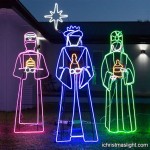Outdoor Stage Lighting Design
Outdoor stage lighting design presents unique challenges and opportunities compared to indoor environments. The absence of a controlled environment necessitates careful consideration of natural light, weather conditions, and the surrounding landscape. Effective outdoor stage lighting enhances performances, creates atmosphere, and ensures both audience and performer safety.
One primary consideration in outdoor stage lighting design is the changing ambient light levels. As the sun sets, the lighting design must adapt to maintain visibility and the desired aesthetic. This often involves a phased approach, with different lighting cues triggered as daylight diminishes. Understanding the trajectory of the sun and its impact on the stage area is crucial for pre-planning and effective execution.
Weatherproofing is paramount in outdoor settings. All lighting fixtures and cabling must be rated for outdoor use and capable of withstanding rain, wind, and temperature fluctuations. The use of IP-rated (Ingress Protection) equipment is essential. This rating system classifies the degree of protection against the intrusion of solids and liquids, ensuring the longevity and reliability of the lighting system.
The choice of lighting fixtures plays a significant role in achieving the desired effect. Commonly used fixtures include PAR cans (Parabolic Aluminized Reflector), LED wash lights, moving head fixtures, and followspots. PAR cans provide a powerful, focused beam, ideal for highlighting specific areas or performers. LED wash lights offer flexibility in color mixing and coverage, allowing for dynamic and vibrant stage washes. Moving head fixtures provide versatility in beam shape, color, and movement, enabling complex and dynamic lighting effects. Followspots are essential for isolating and tracking individual performers on stage.
Power distribution is a critical aspect of outdoor stage lighting. Access to sufficient power outlets and the use of appropriate cabling and distribution boxes are essential for safe and reliable operation. Calculating the total power requirements of the lighting system and ensuring the power source can handle the load is crucial. The use of generators may be necessary in locations without readily available power infrastructure.
Control systems are vital for managing and automating lighting cues. Lighting consoles, ranging from simple to complex, provide the interface for controlling the intensity, color, and movement of lighting fixtures. DMX512 (Digital Multiplex) is the industry standard communication protocol for controlling stage lighting, enabling precise and synchronized control of multiple fixtures.
Safety is a paramount concern in outdoor stage lighting design. Properly secured cabling and fixtures are essential to prevent accidents. GFCI (Ground Fault Circuit Interrupter) protection is necessary to minimize the risk of electrical shock in outdoor environments. Regular inspections and maintenance of the lighting system are crucial to ensure ongoing safety and reliability.
The surrounding environment plays a significant role in the overall design. Trees, buildings, and other structures can impact light spill and visibility. Consideration of the surrounding landscape and its impact on the stage lighting is essential during the planning phase. Minimizing light pollution and respecting the natural environment are important aspects of responsible outdoor lighting design.
Collaboration with other members of the production team, including the stage manager, set designer, and sound engineer, is crucial for a cohesive and successful production. Effective communication and coordination ensure that all technical elements work together seamlessly to enhance the overall performance.
Budget considerations are an inherent part of any lighting design project. Balancing creative vision with financial constraints requires careful planning and prioritization. Exploring cost-effective solutions, such as renting equipment or utilizing energy-efficient LED fixtures, can help maximize the impact within budget limitations.
Rigging and mounting of lighting fixtures require careful planning and execution. Structural integrity and safety are paramount. The use of appropriate rigging hardware and techniques, along with adherence to safety regulations, is essential. Consulting with qualified rigging professionals is recommended for complex outdoor setups.
The impact of wind on lighting fixtures, particularly those suspended at height, must be considered. Ensuring fixtures are securely fastened and capable of withstanding wind loads is crucial for safety. Wind ratings for lighting fixtures should be consulted and adhered to during the design and installation process.
Documentation of the lighting design, including cable runs, fixture placement, and lighting cues, is essential for efficient setup, troubleshooting, and future productions. Detailed documentation facilitates communication among the technical team and ensures consistency in execution.
Regular maintenance and inspection of outdoor lighting equipment are crucial for longevity and performance. Cleaning lenses, checking connections, and replacing worn components are essential maintenance tasks. A preventative maintenance schedule can help avoid costly repairs and ensure the reliability of the lighting system.

Outdoor Concert Lighting And Staging Eventos Montajes

The Eight Best Stage Lights To Liven Up Any Performance Blisslights

Outdoor Aluminum Stage Lighting Truss Design For China And Made In Com

Ld Systems Audio Lighting Stage Design

Amazing Outdoor Stage Set Up Well Done Team Lighting Design

Outdoor Performance Stage Lighting Design Elements Stagelight Fogscreen Beamlight Ledparlight Barlight Guangzhou Sicheng Audio Technology Co Ltd

Talk About The Stage Atmosphere Rendering Effect By Lighting Design Professional Manufacturer Outdoor Wash Light Led Par Studio

J Davis Prosound Lighting Illuminates David Guetta Concert Bi Monthly On Industry Leds Indoor Outdoor Household Commercial Industrial Lights Future Of N

Tourgo Event Lighting Truss With Adjustable Aluminum Stage For Outdoor Al

Stage Lighting Als
Related Posts







